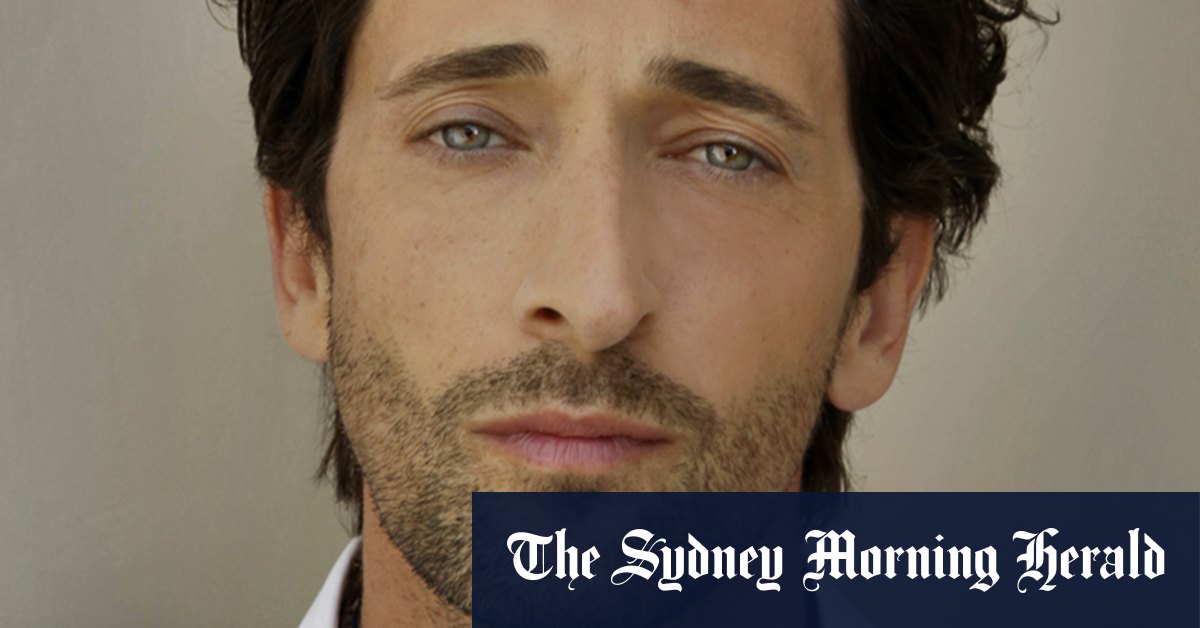
When a three-and-a-half hour film about architecture blitzed the Golden Globe awards earlier this month, few of us saw it coming. Brady Corbet’s monumental The Brutalist won best drama, best director and best actor in a drama for Adrien Brody. Many of those watching the awards at home hadn’t really registered the film’s existence or, if they had, had thought that it was simply too big an ask. Now it’s a must-see.
Brody plays the fictional Brutalist architect of the title, a Bauhaus-trained Hungarian Jew called László Tóth. Having survived the Nazi concentration camp at Buchenwald – where he was imprisoned while his wife Erzsébet (Felicity Jones) was at another camp – Tóth arrives in the United States as a refugee. He winds up working on a building site, abjectly poor and addicted to painkillers, until wealthy patron Harrison Lee Van Buren becomes aware of his reputation as an architect and employs him to design a centre for the arts; he also helps him to bring Erzsébet to America.
The arts centre will sit on the Van Buren family estate, a cultural beacon on a hill that will shine over all Pennsylvania. For Tóth, it is his masterwork. “Promise me it won’t drive you mad,” says Erzsébet. That is not a promise he can make.
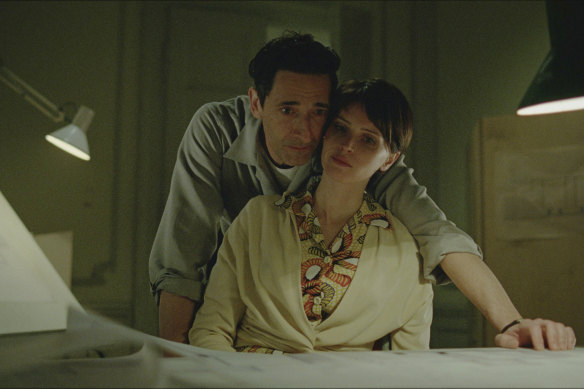
Laszlo Toth (Adrien Brody) and his wife Erzsebet (Felicity Jones) in The Brutalist. Credit: AP
The Brutalist is epic in scale, reflecting the massiveness of the project it chronicles, but it also has the intimate intensity of melodrama. From the start, it is clear that Van Buren’s commission is not just about putting up a building. Swirling below the surface logistics is a complicated play of control, jealousy and opaque desire; Van Buren’s buried yearning is to drink Tóth’s talent dry. The relationship between artist and patron is thus central to the film, but so is the relationship of the artist to art itself.
Even on the page, says Brody, the ambition of Corbet’s project was dazzling. “It was so moving, so vast. That being said, is that always achievable, especially on a modest budget? The answer is no.” Its scope was compelling. It was also unnerving. “Most of the films I’ve selected in my career have been very challenging independent films. Everyone goes in striving to make the best film they can, but there are inevitably many, many obstacles – on every film. And so you just keep hoping and praying for things to align. And that’s what transpired on this film.”
Adrien Brody is 51; he has been working in film since 1989, when he appeared in Francis Ford Coppola’s Life Without Zoe, a segment of New York Stories. In 2003, aged 29, he became the youngest winner of the Oscar for best actor – a record he still holds – for his performance in Roman Polanski’s The Pianist, about a Jewish musician trying to elude the Nazis by living hand to mouth in the rubble of Warsaw. He starved and isolated himself in preparation for that role, which ravaged him both physically and mentally. “It was very painful, but I’m unafraid to sacrifice for my work,” Brody said later.
Brody’s mother, the photographer Sylvia Plachy, came to the United States as a refugee from Hungary during the 1956 uprising against Soviet rule. She was 13, hiding with her parents under a load of corn in a horse-drawn cart to cross the border into Austria as flares shot up around them.
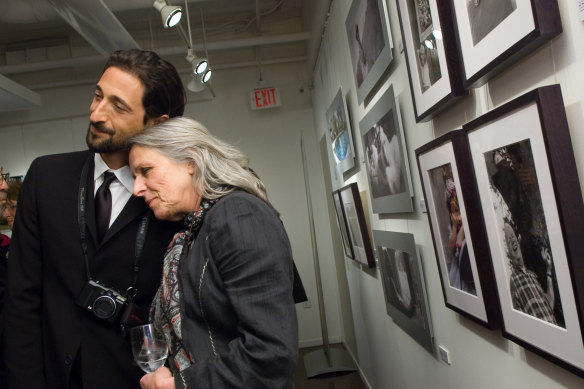
Adrien Brody with his mother, photographer Sylvia Plachy, at the opening of the joint American Character: A Photographic Journey exhibition in Washington in 2009.Credit: Getty Images
“They literally left a war in their home town,” Brody says. “Then they were refugees in Vienna temporarily until they could get passage to the United States. It was a very hard journey for her but more so for my grandparents. My [grandmother] spoke six languages and was able to get more work, but it was harder for [my grandfather], starting again as a foreigner, not really speaking the language. The emotional repercussions and resonance of that have reverberated through our lives.”
Sylvia Plachy worked for the Village Voice, taking photographs of city life. “I see how her experiences as a young girl have shaped her sensitivity and awareness of the sufferings of others,” says Brody. “She memorialises with those images, in an era when New York was very alive and tumultuous, [catching] the spirit of the city but with this sensitivity. I feel that has shaped me, in my yearnings as an artist – to confront what is frightening and painful in the world – and the kinds of projects I choose. I’ve always been drawn to connecting with people who are not quite allowed in.”
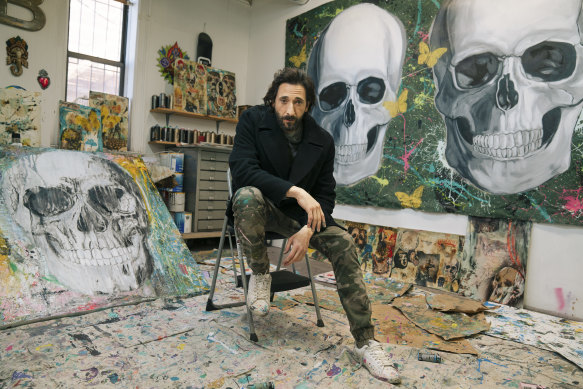
Adrien Brody with some of his paintings in 2022.Credit: NYT
In recent years, Brody has returned to painting alongside acting. “A lot of my work references elements of American culture that are quite aggressive and that I’m a product of, growing up in New York City. I do feel there is a parallel in the journey that brought my mother to the United States, which has then given me a platform to grow as an artist, as a young American, affected both by my own culture and the past.”
He never learned to speak Hungarian at home, although László Tóth’s accent is taken directly from his grandfather’s, but he identified with Tóth the moment he began reading Corbet’s script. Tóth’s journey was a version of his mother’s and, in turn, his own journey was a version of theirs. “And that’s why I have been so grateful to do this movie,” he says.
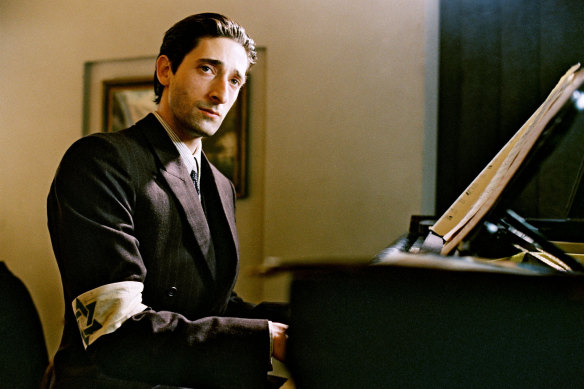
Adrien Brody in his Oscar-winning performance in The Pianist.
Five years after his gruelling work in The Pianist, Brody found a different groove as a comic actor with 2007’s The Darjeeling Limited, the first of five films he has made with ironic stylist Wes Anderson. “I cherish those experiences,” he says. “For example, The Darjeeling Limited was a wonderful life experience, being with Wes and with my fellow actors, living in India together, travelling on a train, the character work and the lightness Wes has afforded me, that until then I’d had few opportunities to do.”

From left, Jason Schwartzman, Adrien Brody and Owen Wilson in Wes Anderson’s The Darjeeling Limited.Credit: FOX SEARCHLIGHT
Loading
Both Anderson and Corbet are strong independent voices, he agrees, but The Brutalist required a different order of commitment. “This is a monumental task – to represent so much and master a dialect. It’s three-and-a-half hours of storytelling that I’m very present in.”
Incredibly, it was made for a pared-back $US10 million. This was despite the fact that Corbet decided to shoot most of it in VistaVision, a large-format process popular in the 1950s, so that it could be shown in 70mm.
“We cut every corner we could to make sure every single cent was on screen,” said Corbet, who is no stranger to struggles with patrons himself, in an interview with Variety. “It was a Herculean effort and I wouldn’t recommend it to anyone, because it was just years and years of working for free, essentially.”
It took seven years to get The Brutalist to the screen, but when it finally premiered at last year’s Venice Film Festival, he won the Silver Lion for best director. At that point, Corbet said, “certain people … were telling me that I would never make another movie”.
He wrote the script with his partner, Norwegian filmmaker Mona Fastvold, inspired by the fictional histories of German novelist W.G. Sebald.
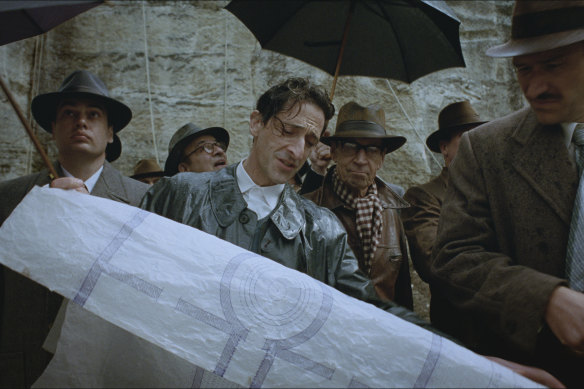
Adrien Brody plays a tormented architect creating his masterwork in The Brutalist.Credit: AP
Loading
“Something that Brady, Mona and I talked about many times was how post-war psychology affected post-war architecture,” says Brody. The concrete blocks, shafts of light and passageways of the centre Tóth designs echo aspects of the camps.
“László’s creation of this centre is almost a rebuilding of his own physical being. It mirrors and reshapes a once-traumatic space for him; he creates a sense of healing and closure in its creation, but also memorialises the past. I think that is very beautiful and very telling of how our circumstances, experiences and most importantly traumas affect who we are.”
The film’s success in Venice, the Golden Globes and the very real hope of a second Oscar for Brody mean that he can focus on what kind of journey he wants to take next. “And for anyone pursuing artistic work, that’s a really good place to be.”
The Brutalist is in cinemas from January 23, with advance screenings on January 18 and 19.
Australia’s László Tóths
The fictional story of László Tóth in The Brutalist echoes that of many architects who fled Nazi Germany for a new life in Australia. Lindy Percival looks at the impact that some of them had on our cities…
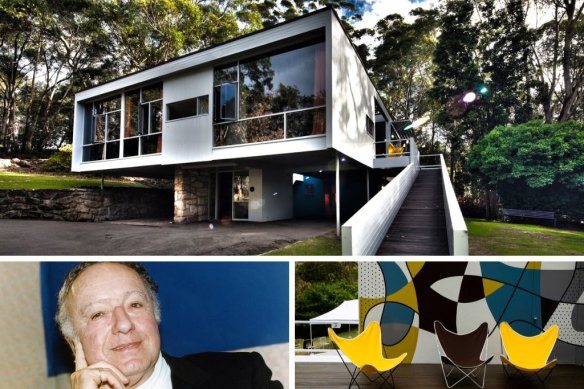
Harry Seidler and the Sydney house he designed for his parents. Credit: Phyllis Wong, Dominic Lorrimer
Harry Seidler was born in Vienna in 1923 and fled to England soon after the Nazi occupation in 1938. He was interned as an enemy alien in Britain and later Canada, before studying architecture in the US. Sydney became his home and creative testing ground after his parents, who’d migrated in 1946, commissioned him to design a house in Wahroonga. Though initially lambasted by traditionalists, Rose Seidler House became a local icon and Seidler went on to design a number of significant – and often controversial – public and private buildings.
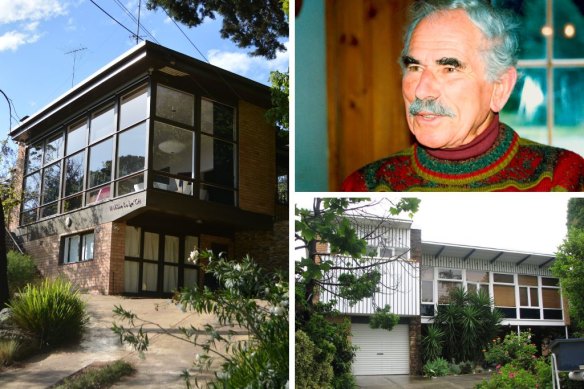
Anatol Kagan’s designs became so popular in Studley Park that the area became known as “Kaganville”; his Lind House in Caulfield North. Credit: Lind House photo: Simon Reeves
Anatol Kagan was born in St Petersburg in 1913 but was living in Germany when the rise of Nazism drove him to Melbourne in 1939. His groundbreaking Bell House, built in Studley Park in 1950, led to so many local commissions that the area became known as “Kaganville”. He revolutionised local domesticity with designs that placed the principal living areas on the upper level, embracing the Australian light. His best-known design, Lind House in Caulfield North, remains a local beacon of modernist architecture.
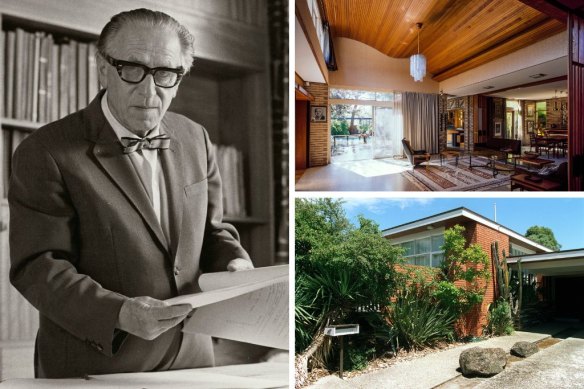
Ernest Fooks; the living room of his own house in North Caulfield; another Fooks design in the same suburb. Credit: Photos: Mark Strizic, Trevor Mein, Rodger Cummins
Ernest Fooks was born in Czechoslovakia in 1906, and was living in Vienna when he fled growing anti-semitism and arrived in Melbourne in 1939. Decades before contemporary architects declared war on the march of “McMansions”, he was advocating for multi-purpose rooms to maximise space in small houses and apartments, and the many local apartment blocks he designed are still regarded as models for urban density.
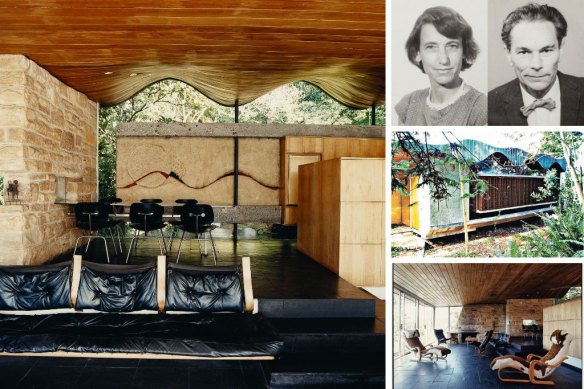
Hugh and Eva Buhrich’s Sydney house has been called “the finest modern house in Australia”. Credit: Michael Wee, Jennifer Soo
Hugh and Eva Buhrich met while studying architecture in Munich but fled Nazi Germany in 1939. Though their credentials were not initially recognised in Australia, Hugh had a 40-year career here, while Eva became a writer and editor for publications including The Australian Women’s Weekly, House and Garden and The Sydney Morning Herald. His best-known design is their home in Castlecrag, completed in 1972. Buhrich House II, once described as “the finest modern house in Australia”, is now listed on the NSW State Heritage Inventory.
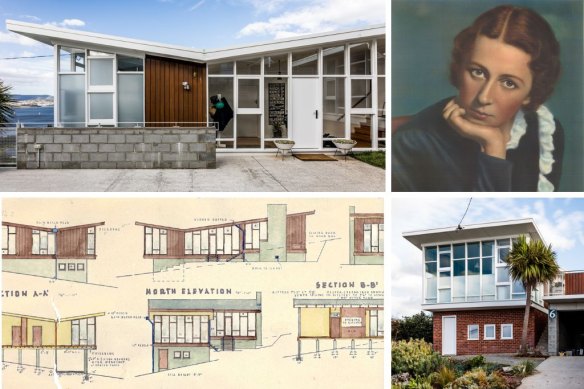
The Longview Avenue House in Hobart designed by Edith Emery and renovated by Taylor + Hinds Architects. Credit: Photos: Adam Gibson; portrait of Edith Emery by permission of her son, Michael Emery; original drawing of Longview Avenue by Edith Emery
Edith Emery was working as a gynaecologist in Austria when she fell foul of the Nazis. When she arrived in Australia in 1938, her medical qualifications weren’t recognised so she turned to her other love, architecture, studying at the University of Tasmania and becoming the state’s first qualified sole female practitioner. Her mostly small-scale domestic designs were largely unacknowledged until a 2023 episode of the ABC’s Designing a Legacy series visited one of her houses in Hobart, unpicking just a part of her remarkable story.
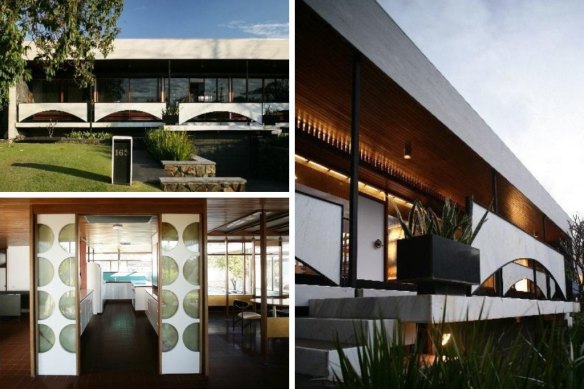
Paganin House in Perth, by Iwan Iwanoff. The house was painstakingly rebuilt following a fire.Credit: Rob Frith
Iwan Iwanoff was a Bulgarian-born architect who studied in Germany before he and his wife arrived in Perth as refugees in 1950. Though his qualifications were not initially recognised here, he went on to design some of Perth’s most iconic homes, striking for their use of raw concrete blocks and decorative brickwork. One of his most stunning, Paganin House, burnt down in 2015 but was painstakingly rebuilt by its passionate owners in a story documented on Restoration Australia.



